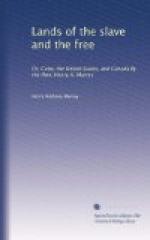These are no fictions, they are plain facts, borne testimony to in many instances by the governors of the colonies; and I might quote an infinite number of similar statements, all tending to prove the rapid growth of idleness and vice in the emancipated slaves, and the equally rapid ruin of the unfortunate proprietor. The principles upon which we legislated when removing the sugar duties is a mystery to me, unless I accept the solution, so degrading to the nation, “that humanity is a secondary consideration to L s.d., and that justice goes for nothing.” If such were not the principles on which we legislated, there never was a more complete failure. Not content with demoralizing the slave and ruining the owner, by our hasty and ill-matured plan of emancipation, we gave the latter a dirty kick when he was falling, by removing the little protection we had all put pledged our national faith that he should retain; and thus it was we threw nearly the whole West India sugar trade into the hands of Cuba, stimulating her energy, increasing her produce, and clinching the fetters of the slave with that hardest holding of all rivets—the doubled value of his labour.
Perhaps my reader may say I am taking a party and political view of the question. I repudiate the charge in toto: I have nothing to do with politics: I merely state facts, which I consider it requisite should be brought forward, in order that the increase of Cuban produce may not be attributed to erroneous causes. For this purpose it was necessary to show that the ruin we have brought upon the free West Indian colonies is the chief cause of the increased and increasing prosperity of their slave rival; at the same time, it is but just to remark, that the establishment of many American houses in Cuba has doubtless had some effect in adding to the commercial activity of the island.
I have, in the preceding pages, shown the retrogression of some parts of the West Indies, since the passing of the Emancipation and Sugar-Duty Acts. Let me now take a cursory view of the progression of Cuba during the same period.—Annual produce—
Previous to Emancipation. 1852.




